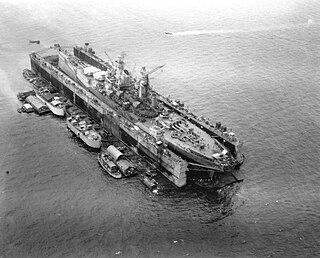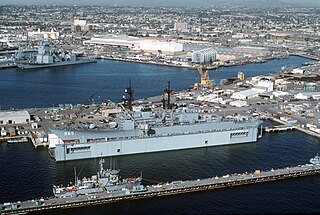The United States Navy, United States Coast Guard, and United States National Oceanic and Atmospheric Administration (NOAA) use a hull classification symbol to identify their ships by type and by individual ship within a type. The system is analogous to the pennant number system that the Royal Navy and other European and Commonwealth navies use.

USS Finback (SSN-670), a Sturgeon-class attack submarine, was the second ship of the United States Navy to be named for the finback, the common whale of the Atlantic coast of the United States.

The Pearl Harbor Naval Shipyard and Intermediate Maintenance Facility is a United States Navy shipyard located in Pearl Harbor, Hawaii on 148 acres. It is one of just four public shipyards operated by the United States Navy. The shipyard is physically a part of Joint Base Pearl Harbor–Hickam.
United States ship naming conventions for the U.S. Navy were established by congressional action at least as early as 1862. Title 13, section 1531, of the U.S. Code, enacted in that year, reads, in part,
The vessels of the Navy shall be named by the Secretary of the Navy under direction of the President according to the following rule: Sailing-vessels of the first class shall be named after the States of the Union, those of the second class after the rivers, those of the third class after the principal cities and towns and those of the fourth class as the President may direct.

USS Dewey (YFD-1) was a floating dry dock built for the United States Navy in 1905, and named for American Admiral George Dewey. The auxiliary floating drydock was towed to her station in the Philippines in 1906 and remained there until scuttled by American forces in 1942, to prevent her falling into the hands of the invading Japanese.

USS Richland (YFD-64/AFDM-8) was an AFDM-3-class medium auxiliary floating drydock built in California for the U.S. Navy. Originally named USS YFD-64, she was towed to the Philippines and Guam where she served until war's end.

Naval Station Pearl Harbor is a United States naval base on the island of Oahu, Hawaii. In 2010, along with the United States Air Force's Hickam Air Force Base, the facility was merged to form Joint Base Pearl Harbor–Hickam. Pearl Harbor is the headquarters of the United States Pacific Fleet.

An auxiliary floating drydock is a type of US Navy floating dry dock. Floating dry docks are able to submerge underwater and to be placed under a ship in need of repair below the water line. Water is then pumped out of the floating dry dock, raising the ship out of the water. The ship becomes blocked on the deck of the floating dry dock for repair. Most floating dry docks have no engine and are towed by tugboats to their destinations. Floating dry docks come in different sizes to accommodate varying ship sizes, while large floating dry docks come in sections and can be combined to increase their size and lift power. Ballast pontoon tanks are flooded with water to submerge or pumped dry to raise the ship.

USS AFDM-2,, is an AFDM-3-class medium auxiliary floating drydock built in Mobile, Alabama by the Alabama Drydock and Shipbuilding Company for the U.S. Navy. Originally named USS YFD-4, Yard Floating Dock-4, she operated by Todd Shipyards at New Orleans, Louisiana for the repair of US ships during World War II. YFD-4 was renamed an Auxiliary Floating Dock Medium AFDM-2 in 1945 after the war.

USS ABSD-2, later redesignated as AFDB-2, was a ten-section, non-self-propelled, large auxiliary floating drydock of the US Navy. Advance Base Sectional Dock-2 was constructed in sections during 1942 and 1943 by the Mare Island Naval Shipyard in Vallejo, California for World War II. Her official commissioning ceremony took place on 14 August 1943 with CDR. Joseph J. Rochefort in command. With all ten sections joined, she was 927 feet long, 28 feet tall, and with an inside clear width of 133 feet 7 inches. ABSD-2 had a traveling 15-ton capacity crane with an 85-foot radius and two or more support barges. The two side walls were folded down under tow to reduce wind resistance and lower the center of gravity. ABSD-2 had 6 capstans for pulling, each rated at 24,000 lbf (110,000 N) at 30 ft/min (0.15 m/s), 4 of the capstans were reversible. There were also 4 ballast compartments in each section.
Everett-Pacific Shipbuilding & Dry Dock Company was established in 1942 to build ships needed for World War II. Yard construction began on 1 March 1942. As part of the Emergency Shipbuilding Program the US Navy provided some of the capital to start Everett-Pacific Shipbuilding at Port Gardner Bay in Everett, Washington. Everett-Pacific was sold in 1945 to the Pacific Car and Foundry, who was already a major manufacturer of railcars and trucks. Pacific Car and Foundry was building barges for the US Navy during World War II at plants in Renton, Seattle and Tacoma in the state of Washington. The lease for the shipyard in Everett, Washington ended in 1949 and the yard closed. Pacific Car and Foundry in 1972 changed its name to Paccar Inc. to reflect its major products. The Everett-Pacific shipyard site later became part of Western Gear, a heavy machinery manufacturer. in 1987 the shipyard became part of Naval Station Everett. Everett-Pacific Shipbuilding was started by William Pigott Jr. a Seattle businessmen and his brother Paul Pigott (1900-1961). William Pigott Jr. was born in 26 Aug. 1895 in Pueblo, CO and died on 8 July 1947 in San Francisco, CA.
Pollock-Stockton Shipbuilding Company was established in 1942 to build ships needed for World War II. As part of the Emergency Shipbuilding Program the US Navy provided some of the capital to start Pollock-Stockton Shipbuilding at Stockton, California. The shipyard was located at San Joaquin River and Stockton Channel, near Louis Park. After the war the shipyard closed down in February 1946.
In 1989, the United States Navy was on the verge of massive cuts to military spending cuts including ship and aircraft procurement. These forces were expected to fight the Soviet Union, Warsaw Pact and other potential adversaries in case of a war breaking out. At this time, the USS Kitty Hawk (CV-63) of the Pacific Fleet was out of commission for Service Life Extension Program (SLEP) modernization leaving the 3rd Fleet with less carriers.

Naval Advance Base Espiritu Santo or Naval Base Espiritu Santo, most often just called Espiritu Santo, was a major advance Naval base that the U.S. Navy Seabees built during World War II to support the Allied effort in the Pacific. The base was located on the island of Espiritu Santo in the New Hebrides, now Vanuatu, in the South Pacific. The base also supported the U.S. Army and Army Air Corps, U.S. Coast Guard, and US Marine Corps. It was the first large advance base built in the Pacific. By the end of the war it had become the second-largest base in the theater. To keep ships tactically available there was a demand for bases that could repair and resupply the fleet at advance locations, rather than return them to the United States. Prior to December 7th, Pearl Harbor was the U.S. fleet's largest advance base in the Pacific. Espiritu became capable of all aspects necessary to support the Fleet's operations from fleet logistics in fuel, food, and ammunition, to transport embarkation for combat operations or returning to the continental United States. The ship repair facilities and drydocks were capable of attending to most damage and routine maintenance. Had it not existed, ships would have had to return to Pearl Harbor, Brisbane, or Sydney for major repairs and resupply. The base became a major R and R destination for the fleet.

USS Resourceful (AFDM-5),, was a AFDM-3-class floating dry dock built in 1943 and operated by the United States Navy.

USS AFDM-3,, was the lead ship of the AFDM-3-class floating dry dock built in 1943 and operated by the United States Navy.

USS Competent (AFDM-6),, was an AFDM-3-class floating dry dock built in 1943 and operated by the United States Navy.

The USS Sustain (AFDM-7),, was a AFDM-3-class floating dry dock built in 1945 and operated by the United States Navy.

USS Steadfast (AFDM-14) is a AFDM-14-class floating dry dock built in 1945 and operated by the United States Navy.













